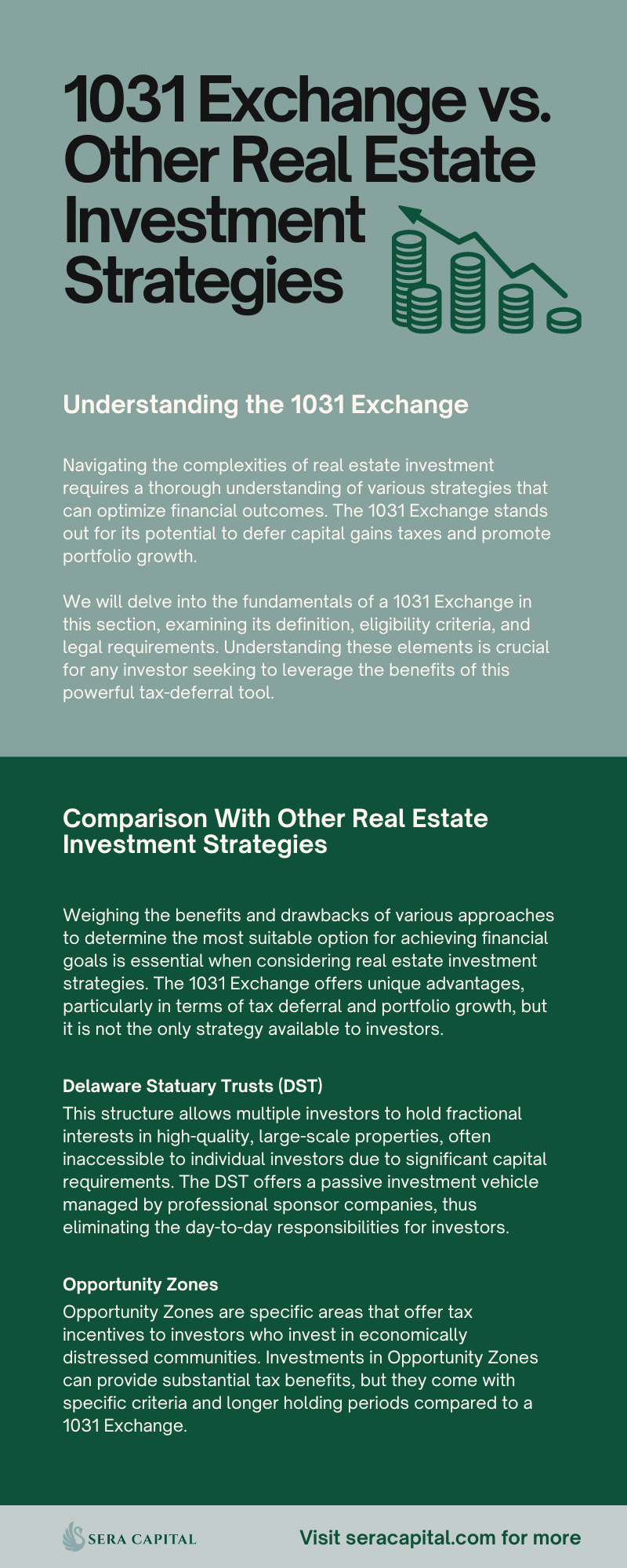1031 Exchange vs. Other Real Estate Investment Strategies

Carl E. Sera, CMT
June 5, 2024
Understanding the variety of strategies available is crucial for maximizing returns and minimizing risks in the real estate industry. One such strategy that stands out is the 1031 Exchange.
This walkthrough aims to provide an in-depth comparison between the 1031 Exchange and other real estate investment strategies. We will equip you with the knowledge needed to make informed decisions by exploring the benefits, legal requirements, and practical applications.
Understanding 1031 Exchange
Navigating the complexities of real estate investment requires a thorough understanding of various strategies that can optimize financial outcomes. The 1031 Exchange stands out for its potential to defer capital gains taxes and promote portfolio growth.
We will delve into the fundamentals of a 1031 Exchange in this section, examining its definition, eligibility criteria, and legal requirements. Understanding these elements is crucial for any investor seeking to leverage the benefits of this powerful tax-deferral tool.
What Is a 1031 Exchange?
A 1031 Exchange, named after Section 1031 of the Internal Revenue Code, is a powerful tax-deferral strategy for real estate investors. It allows investors to defer capital gains taxes on the sale of a property by reinvesting the proceeds into a like-kind property. This strategy offers significant tax advantages, enabling investors to preserve their capital and continue to grow their portfolios as previously mentioned.
Eligibility Criteria
Investors must meet certain criteria to qualify for a 1031 Exchange. The exchanged properties must be of similar nature or character, even if they differ in grade or quality. Additionally, you must hold these properties for investment or productive use in a trade or business. Additionally, investors have 45 days to identify potential replacement properties and 180 days to complete the exchange from the date of the initial property sale.
Legal Requirements
Compliance with IRS regulations is essential for a successful 1031 Exchange. A neutral third party, known as a Qualified Intermediary, will oversee the exchange to avoid constructive receipt of funds. Accurate and timely documentation, including identification of replacement properties and sales contracts, is crucial. Missing the 45-day and 180-day deadlines can disqualify the exchange, so strict adherence to these timelines is necessary.
Comparison With Other Real Estate Investment Strategies
Weighing the benefits and drawbacks of various approaches to determine the most suitable option for achieving financial goals is essential when considering real estate investment strategies. The 1031 Exchange offers unique advantages, particularly in terms of tax deferral and portfolio growth, but it is not the only strategy available to investors.
This section will provide a comparative analysis of the 1031 Exchange vs. other popular real estate investment strategies, such as Opportunity Zones and Delaware Statuary Trusts. Investors can make more informed decisions tailored to their specific objectives and risk tolerance by understanding the key differences and potential outcomes of these strategies.
Delaware Statuary Trusts (DST)
This structure allows multiple investors to hold fractional interests in high-quality, large-scale properties, often inaccessible to individual investors due to significant capital requirements. The DST offers a passive investment vehicle managed by professional sponsor companies, thus eliminating the day-to-day responsibilities for investors.
DSTs come with a host of advantages, making them an increasingly popular choice among real estate investors. Some notable benefits include providing investors with the opportunity to diversify their portfolios by owning shares in multiple properties across various geographical locations and sectors.
Also, the properties held in a DST usually produce stable, predictable income streams due to long-term lease agreements with creditworthy tenants. Investors also benefit from the expertise of professional asset managers who handle all aspects of property management, from maintenance to tenant relations.
Since external sponsors manage DSTs, the investment’s success largely depends on the competence and effectiveness of these management teams. Reach out to Sera Capital today to determine whether a Delaware statuary trust is the investment opportunity that best suits your goals.
Opportunity Zones
Opportunity Zones are specific areas that offer tax incentives to investors who invest in economically distressed communities. Investments in Opportunity Zones can provide substantial tax benefits, but they come with specific criteria and longer holding periods compared to a 1031 Exchange.
That said, according to the IRS, the benefits you receive will vary, with one key differentiating factor being the Quality Opportunity Fund (QOF). The QOF is an investment opportunity you can seek using the capital gains from deferred taxes. The maximum benefit comes after a ten-year hold.
Investing in an Opportunity Zone can also positively impact community growth and economic development.
Investors can leverage Opportunity Zones as part of a diversified strategy to optimize both financial returns and positive societal impacts by carefully evaluating eligibility requirements, investment criteria, and potential risks. As always, professional advice and due diligence are critical in making informed investment decisions that align with individual financial goals and risk tolerance.
Maximizing 1031 Exchange
Successfully navigating a 1031 Exchange requires strategic planning and a thorough understanding of the process. Investors can maximize the benefits of a 1031 Exchange by adhering to critical timelines, leveraging expert advice, and staying informed about market trends. The following tips provide practical guidance to ensure a smooth and profitable transaction.
Timeline Considerations & Market Knowledge
Start the process well in advance to allow ample time for identifying and closing on replacement properties. Engage professionals such as experienced real estate agents, attorneys, and qualified intermediaries to help you navigate the complexities of the exchange successfully.
Stay informed about market trends and property values to make strategic investment decisions. Utilizing data and insights can help identify properties with strong growth potential, ensuring the long-term success of your investments.
Property Identification Rules
Identifying replacement properties comes with three primary rules, including the Three-Property Rule. This rule involves an investor identifying a maximum of three potential replacement properties, regardless of market value.
The 95% Rule permits identification of any number of properties, but investors must acquire at least 95% of the total identified value. The third rule is the 200% Rule, which allows the identification of an unlimited number of properties, provided their total value does not exceed 200% of the relinquished property's value.
The 1031 Exchange stands out as an effective tool for real estate investors, offering unparalleled tax-deferral benefits and opportunities for portfolio growth. Consult a professional to explore how you can integrate a 1031 Exchange into your investment strategy. Contact our team at Sera Capital to schedule a free consultation today.

Categories
Strategize Your Success
